#icons matisse
Explore tagged Tumblr posts
Text
Bring the Timeless Beauty of Matisse into Your Home
Discover the elegance of Henri Matisse’s art through our exclusive collection of high-quality downloadable wall art. Perfect for art lovers and interior design enthusiasts alike, these prints capture the essence of Matisse’s innovative and vibrant style. Whether you're looking to add a touch of sophistication to your living room, office, or bedroom, these artworks are sure to make a statement.
Blue Nude II: Inspired by one of Matisse’s most famous works, this print embodies the graceful curves and bold simplicity that define his iconic “Blue Nude” series. The striking contrast of deep blue against a minimalist background brings a sense of calm and elegance, making it a perfect addition to any space.
Botanic Cut-Out: This piece channels Matisse’s love for nature and his mastery of the cut-out technique. The organic, flowing shapes of the botanical design are both modern and timeless, offering a fresh, vibrant look that will brighten any room.
Flower Market: Infused with the vibrant colors and joyful patterns Matisse is celebrated for, this print is a modern interpretation of his floral compositions. The lively arrangement of flowers, rendered in bold and cheerful hues, is ideal for adding a pop of color and a playful touch to your décor.
Each print in this collection has been carefully crafted to capture the essence of Matisse’s groundbreaking style while offering a fresh and contemporary take on his work. Download, print, and display these artworks in your home to enjoy the timeless beauty of Matisse every day.
Inspiring and motivating quotes, famous sayings, and poems that you can use to decorate your home, workplace, or office. Visit our store at: https://dunaartgallery.etsy.com Choose from our best motivational quotes and poems. Find unique wall art from our selection for your home!
#etsy#etsysale#henri matisse#homestyle#home decor#interiordesign#love quotes#painting#art#etsystarseller#modern art#artcollector#abstractart#visualart#abstract#arthistory#botanicart#botanical#botanic illustration#flowers#woman#mature woman#beauty#elegant#beautiful
32 notes
·
View notes
Text

FLIGHT! Sky's Picnic Pickup
ATTACK ON: @zeddye
CHARACTER/S: Sky, Tink, Druffs, Cookie, Rosie, Goldie, Matisse, Professor Z, UnReone
STATE: Revenge - Mass Attack




WRITTEN ONE-SHOT FIC BELOW CUT
Crunch. Sweetness with a hint of tart flavor flows in. It's just nice to enjoy apples with friends... and biscuits... and juice..... yeah, no, I guess that's all there is to it.
The hike up was hectic. Everycritter were focused more on making sure all is in one piece. Anything is possible in the wilderness. Like Goldie craving honey and encountering a tree filled with it. There's even a fight that involves a bear thingy with a moon on its forehead. Can't really blame anyone in particular for leaving behind the picnic baskets after the altercation...erherm Riri erherm.
Good thing Sky went to retrace their steps to pick it up. While waiting, Matisse has been picking up apples in the nearby grove. Just to have something to munch on. Professor Z is helping her out. She does not mind his rambling about the variety of apples in color, she's just glad to have company.
One of the recovered baskets sit idly behind Druffs. A pack of biscuits was opened. Tink swears that each shape have its own distinct flavor. Reone have found at least three four-leaf clover in her area, that's neat. Rosie is content with cloud watching as her friends chatter on.
Her ear twitches. Flapping. Swooshing through the clouds, there's the iconic cockatiel flying through. Sky is definitely not flying ahead of the designated spot nuh uh.
"Skyyy, over here!!!"
Ah she was definitely flying back there. It's not like Sky completely missed her friends and no critter have any proof otherwise. She picks up speed, the sound of her wings catching others' attention.
Swiftly, Sky gains altitude — her form a blur of white and yellow feathers. It's like a tiny whirlpool in the sky. A rush of wind hits her face, making her smile. She lets go of the picnic basket, plummeting into a possible mess. With a decisive twirl, she dives backwards, tailing behind as she spins midair. She caught the basket! Noises of awe plays from that sum of tricks. One could even call that bit awesum.
It's really cool she did that. It's extra cool that they can now begin their picnic.
7 notes
·
View notes
Text
Born in Budapest in 1913 to a Jewish mother and an Indian father, Amrita Sher-Gil was their first of two children whom they raised in luxury. [...]
She said of her time there, “Europe belongs to Picasso, Matisse and many others, India belongs only to me.” [....] “I realized my artistic mission then: to interpret the life of Indians and particularly of the poor Indians pictorially, to paint those silent images of infinite submission and patience, to depict their angular brown bodies."
im always fascinated by the token poc passed around as queer icons, people infinitely alienated from working class lives and espousing the comforting orientalism the west likes to hear.
44 notes
·
View notes
Text
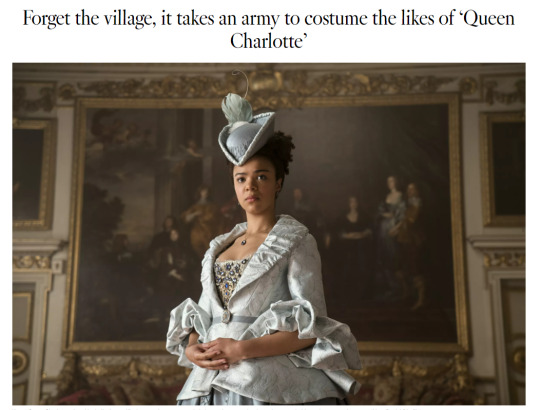
Young Queen Charlotte, played by India Amarteifio, keeps to innocent pastels in her early scenes, but her colors grow bolder as her power does too. (Liam Daniel/Netflix)
BY VALLI HERMAN
In the first minutes of the “Bridgerton” prequel “Queen Charlotte,” the namesake character complains heartily how her elaborate gown and its restrictive corset made of brittle and sharp whalebone means that if she moves too much, “I might be sliced and stabbed to death by my undergarments.”
Oh, dearest gentle reader, young Queen Charlotte hasn’t suffered in vain. Her every ensemble, and those of the show’s sizable cast, are crafted with such sumptuous detail, that surely all who view them would gladly have them suffer even more.
Even though period costumes are notoriously cumbersome, Emmy-winning costume designer Lyn Elizabeth Paolo and co-costume designer Laura Frecon dispel notions that the actors suffered much (thanks to light, modern fabrics and stretchy panels in their corsets). Still, the yearlong shoot in grand estates across the United Kingdom overlapped the pandemic lockdown and required worldwide sourcing. It seems that their brand of elegant finery was a tonic for distress, and a cause for celebration. The work, helped by a 220-person costume crew, has earned them a 2023 Emmy nomination for period costumes.
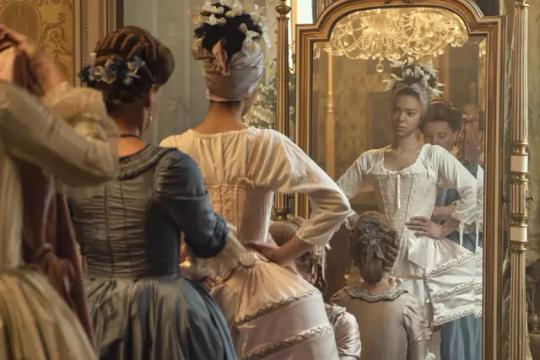
Replica undergarments were crafted from light, modern fabrics and stretchy panels to be slightly more comfortable than the actual period clothing. (Liam Daniel/Netflix)
“This [shoot] was challenging, but also joyful. Every time a piece of a costume would come back, it was, ‘Oh, my God! It looks better than we thought it would.’ There was a lot of joy there,” says Paolo, the longtime designer for other Shonda Rhimes productions, such as “Inventing Anna” and “Scandal.”
The six-episode costume drama on Netflix explores the early days of the difficult marriage of Queen Charlotte (India Amarteifio) and King George III (Corey Mylchreest). The fictionalized story of the actual royals takes place in two time periods — the Georgian era of the 1760s and the later Regency era in which “Bridgerton” is set — and includes key characters from the original show. There are several grand balls, a royal wedding and a coronation to wardrobe. No biggie.
Or so Paolo was led to believe.
“I remember Sara Fischer, who is head of production at Shondaland, called me and said, ‘Shonda has this idea for a small, intimate show. She really wants you to do it.’ And, what are you going to say?” recalls Paolo, who was a consultant on Season 2 of “Bridgerton.”
She invented a time-twisting concept inspired by Monet and Matisse paintings and modern fashion designers who themselves referenced historical costume such as John Galliano, Alexander McQueen, Moschino, Zuhair Murad and Christian Dior in his New Look era. Yet Paolo kept the silhouette appropriately Georgian.
“The pitch was, we kind of want it to look like a Met Ball … but to be slightly more on point with the period. We still wanted to have our own stylistic elements that would make sure that the modern eye understood the costumes,” Paolo says.
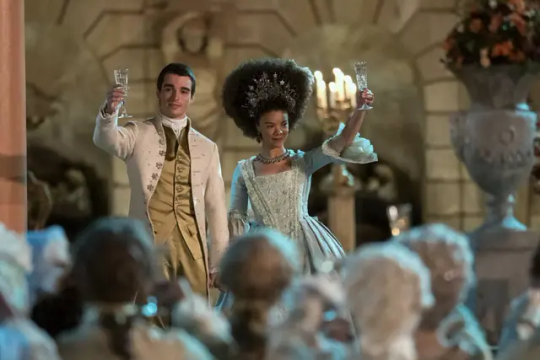
Corey Mylchreest as King George and India Amarteifio as Queen Charlotte all but sparkle in their lustrous clothing. (Nick Wall/Netflix)
“For the men, we had images of rock ‘n’ roll icons from the ‘70s and ‘80s. So a lot of images of Prince, the New Romantics and Adam Ant. All those people back then who had that pirate chic going on.”
That vision required a mostly custom-made wardrobe that sourced from London, Los Angeles, New York, Budapest and Spain. Jewelers Joseff of Hollywood, Manhattan’s Larkspur & Hawk and Italy’s Pikkio custom made the period jewelry and other adornments. British manufacturer James Hare supplied traditional fabrics as did a mill hours from London that wove custom fabrics. Smaller artisan shops focused on hand embroidery or a particular character.
“It was sort of a small army,” says Paolo, who relied on the organizational skills of Frecon. A giant calendar and flow chart helped them track the flow of work, particularly of the embroidered pieces, which were outsourced to UK specialists Twan Lentjes Creations, Beth Parry and Hattie McGill, whose Instagram accounts illustrate their handiwork.
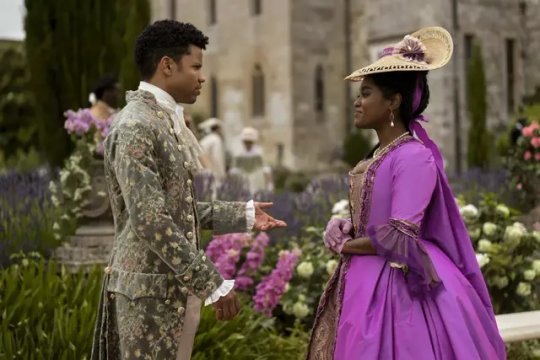
Other members of the court stand out in patterned fabrics (on Tunji Kasim as Adolphus) and brightly colored gowns with hats (Arsema Thomas as Agatha Danbury).
“It’s so complicated,” Paolo says, describing a process of sample making, initial embroidery, further tailoring and additional hand embellishing before a pattern piece is ever fitted into a garment. Even fabric-covered buttons were embroidered.
The women’s gowns are especially intensive. The earlier dresses, from 1760 onward, required 13 to 20 yards of fabric and at least four weeks of construction; five if they’re heavily embellished. Each ensemble requires petticoats that can add five to 10 more yards each, plus a corset, a pannier (a cage-like underpinning), a padded bum roll, shoes, stockings and garters. The jewelry sets were matched to each costume and included rings, earrings, necklaces, bracelets and tiara-like hair jewelry that was fitted into fantastical wigs by hair and makeup designer Nic Collins.
With two sets of characters to dress in two different eras, the costume designers were careful to build visual continuity, typically with color. Young Queen Charlotte, for example, keeps to innocent pastels in her early scenes, but her colors grow bolder as her power does too. The designers cannot precisely count the number of costume changes, or quantify the number of pieces they used, only to say “in the thousands.” Paolo says Jeff Jur, director of photography, was on board to capture the spectacle and regularly texted her and Frecon to say, “‘I’m doing a full head-to-toe shot of this one.”
Still, it’s tricky to absorb all of the detail, even though it’s there on the hand-embroidered initials on a man’s handkerchief, or the restored antique jet beading and lace on Queen Charlotte’s mourning gown, or the Easter eggs, as Paolo calls the references she wove into many costumes, particularly those in the final episode, which features an astronomy-themed ball, hosted by the king and queen.
King George loves astronomy, so stars and moons are embroidered and beaded into their clothes. The ball was shot outdoors at night, which usually obscures costume details. Jur expertly lit the scene to illuminate the clothes that were so laden with sparkly bits that they twinkle.
Though the final episode was picked to submit for Emmy consideration, the choice was “brutal,” Paolo said. “It’s a huge group of amazingly talented people who all deserve recognition. If we are lucky enough to win, I would want 220 miniature ones to hand out to everyone.”
#queen charlotte: a bridgerton story#india amarteifio#corey mylchreest#queen charlotte#king george iii#charlotte x george#charlottegeorge#tunji kasim#arsema thomas#prince adolphus#lady danbury#netflix#!
50 notes
·
View notes
Text

Original photo Paula Cuello. July 28,2019
COLLIOURE, FRANCE.
Collioure, a charming coastal town in southern France, is an idyllic destination that blends stunning natural scenery with rich cultural history. Nestled between the Mediterranean Sea and the Pyrénées mountains, this town is known for its colorful waterfront houses, historic fortresses, and vibrant artistic heritage. The calm, turquoise waters of its beaches make it a great spot for swimming, sunbathing, and leisurely strolls, perfect for travelers seeking a peaceful escape.
One of Collioure's main attractions is the Château Royal, an impressive 13th-century castle with breathtaking views of the coastline. Nearby, the iconic Notre-Dame-des-Anges church, with its distinct bell tower, stands elegantly at the water's edge, adding a timeless beauty to the town’s panorama. Collioure also has a rich artistic legacy, having inspired painters like Henri Matisse and André Derain, whose works reflect the town’s vivid colors and relaxed atmosphere.
Strolling through Collioure's narrow, winding streets, visitors can enjoy boutique shops, local art galleries, and charming cafes. With its laid-back charm, historic sites, and natural beauty, Collioure is a delightful getaway on the French Riviera, embodying the essence of Mediterranean allure.
2 notes
·
View notes
Text
Paris Cafe 1935

The interior view of Café Gourand in the Montmartre district of Paris in 1935 transports us to a vibrant and artistic era in one of the city's most iconic neighborhoods. Montmartre, known for its bohemian atmosphere and artistic heritage, was a hub for writers, painters, and musicians, making cafés like Gourand essential social spaces for creativity and conversation.
As we step into the café, we can imagine the warm glow of lights reflecting off polished wood surfaces, with small round tables arranged for intimate gatherings. The décor likely featured a mix of Art Deco and traditional French styles, showcasing the elegance of the time. Patrons may have lounged in comfortable chairs, sipping coffee or enjoying a glass of wine while engaging in lively discussions about art, politics, and the cultural scene.
Café culture was a hallmark of Parisian life, and establishments like Café Gourand provided not just a place to eat and drink, but also a backdrop for the social fabric of the city. Artists and intellectuals often frequented these cafés to share ideas and find inspiration. The ambiance was likely filled with the sounds of clinking glasses, the chatter of friends, and perhaps the soft notes of a musician playing in the corner, adding to the café's charm.
In 1935, the world was still feeling the effects of the Great Depression, but Paris maintained its allure as a center for art and culture. The city was alive with energy, and the Montmartre district, with its winding streets and iconic Sacré-Cœur Basilica, continued to attract those seeking creativity and expression.
Café Gourand exemplified the spirit of the time, serving as a meeting place for artists like Pablo Picasso and Henri Matisse, who would have mingled with the everyday Parisians enjoying their leisure time. This café encapsulated the essence of a moment in history where art and life intertwined, leaving an indelible mark on the cultural landscape of Paris.
2 notes
·
View notes
Text
Top Museums in Paris That Are Free to Visit

Paris, a city renowned for its art and culture, is home to some of the world's most prestigious museums. While many of these institutions charge hefty admission fees, several outstanding museums offer free entry, allowing you to immerse yourself in art and history without spending a dime. Whether you're a seasoned art lover or a curious traveler, these museums provide a fantastic opportunity to explore the rich cultural tapestry of Paris. Here’s a guide to the top museums in Paris that are free to visit.
1. Musée d'Art Moderne de la Ville de Paris
The Musée d'Art Moderne de la Ville de Paris is dedicated to 20th-century art and features an impressive collection, including works by artists such as Picasso, Braque, and Delaunay. The museum's sleek architecture and stunning views of the Seine make it a perfect spot for art enthusiasts.
Highlights:
Free entry to permanent collections
Diverse exhibitions featuring contemporary art
Plan your visit with ease using Trip.com for information on current exhibitions and nearby attractions.
2. Petit Palais
The Petit Palais, also known as the City of Paris Museum of Fine Arts, houses a remarkable collection of paintings, sculptures, and decorative arts. Its stunning architecture and beautiful gardens make it a serene retreat in the bustling city.
Highlights:
Free entry to the permanent collections
Notable works by artists like Courbet and Monet
To enhance your visit, check Trip.com for guided tours and local dining options.
3. Musée Carnavalet
This museum is dedicated to the history of Paris, from its origins to the present day. Housed in two beautiful mansions, the Musée Carnavalet features a diverse collection of paintings, photographs, and artifacts that tell the story of the city.
Highlights:
Free admission to the permanent collections
Engaging exhibits on the French Revolution and more
Make the most of your visit by exploring Trip.com for insights on the museum’s layout and nearby attractions.
4. Maison de la Photographie
For photography enthusiasts, the Maison de la Photographie offers an ever-changing array of exhibitions from both established and emerging photographers. This museum provides a platform for contemporary photography and is a gem for anyone interested in visual arts.
Highlights:
Regularly changing exhibitions with free entry
A cozy atmosphere ideal for reflection
Check Trip.com for the latest exhibition schedules and recommendations for your visit.
5. Musée des Arts et Métiers
This fascinating museum is dedicated to the history of inventions and technological advancements. From ancient tools to modern innovations, the Musée des Arts et Métiers showcases a wide array of exhibits that are both educational and entertaining.
Highlights:
Free access to the permanent collections
Exhibits featuring the original Foucault Pendulum
To navigate your way through this unique museum, consider booking a guided experience through Trip.com.
6. Musée de la Vie Romantique
Nestled in the charming district of Montmartre, the Musée de la Vie Romantique celebrates the Romantic era in Paris. The museum, which was once the home of artist Ary Scheffer, features paintings, letters, and artifacts that evoke the spirit of the 19th century.
Highlights:
Free admission to the museum and its gardens
A quaint café perfect for a break
Discover more about this hidden gem and plan your visit using Trip.com.
7. Musée de l'Orangerie
While there is a fee for temporary exhibitions, the permanent collection at the Musée de l'Orangerie is free on the first Sunday of each month. This museum houses Monet's iconic Water Lilies series, alongside works by Cézanne, Renoir, and Matisse.
Highlights:
Stunning display of Impressionist and Post-Impressionist art
Beautiful setting in the Tuileries Gardens
For the best times to visit, check out Trip.com for updates and tips.
8. Musée d'Histoire de la Médecine
Located within the historic Université Paris Descartes, this unique museum focuses on the history of medicine. It features a vast collection of medical instruments and artifacts, making it an intriguing visit for anyone interested in the medical field.
Highlights:
Free access to a rich history of medicine
Interesting displays of ancient medical practices
Plan your visit and find related experiences on Trip.com.
9. Musée des Planètes
While lesser-known, the Musée des Planètes is a captivating small museum that explores the universe and our solar system. With interactive exhibits and stunning visuals, it's a delightful stop for families and science enthusiasts alike.
Highlights:
Free entry to all exhibits
Hands-on activities for children
Check Trip.com for any special events or workshops that might be happening during your visit.
10. La Cinémathèque Française
Film lovers will appreciate the La Cinémathèque Française, which offers free access to a permanent exhibition on the history of cinema. With memorabilia, artifacts, and interactive displays, it’s a treasure trove for anyone passionate about films.
Highlights:
Free entry to the permanent collection
Regular screenings and events
To find out about upcoming events or screenings, visit Trip.com for more details.
Conclusion
Exploring Paris doesn’t have to break the bank, especially with these incredible museums offering free entry. From contemporary art to the history of medicine, there's a wealth of culture waiting to be discovered. Whether you're visiting for the first time or returning to uncover new gems, these museums provide a unique glimpse into the heart of Parisian life.
For a seamless travel experience in Paris, including curated tours and insights on local attractions, check out Trip.com. With the right planning, you can enjoy all that Paris has to offer—without spending a fortune!
3 notes
·
View notes
Text
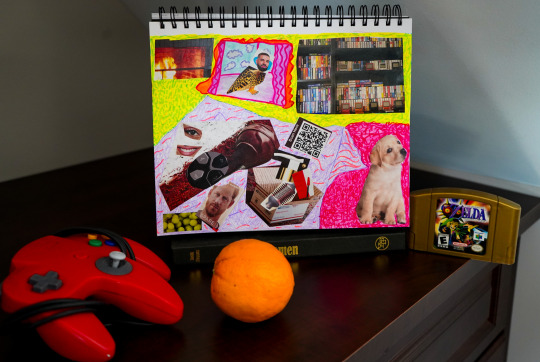
As I began working on my still-life creation, I faced a challenge in drawing a table that matched my abstract art style. Seeking inspiration, I stumbled upon a fun still-life by Matisse. His work featured a table emerging from the corner of the composition. I drew insights from his work and decided to follow suit, outlining the area around the table with a window in the background, wall space, and a floor area. This approach allowed me to create a sense of depth and dimension in my artwork.
After I mapped out the interior space, I added the first layer of color to bring it to life. Then, I searched for images to use in the collage. I knew I could always return to perfecting the use of color later.
I grabbed some magazines and set a 30-minute timer to stay focused. The timer helps me make decisive decisions while cutting things out.
When the timer went off, my collection consisted of various items, including everyday commercial products, mouth-watering food, and iconic pop culture figures.
After cutting out the images, I took my time to arrange them on the page in various ways. I experimented with different combinations, carefully deciding on the best placement for each item.
I gave my chocolate cake a face and morphed an owl with Drake's face.
After affixing the images, I grabbed my art supplies and revisited each section, intensifying the colors.
As a millennial, I grew up playing video games and indulging in sugary treats. However, when I recently created a collage depicting my life in 2023, I realized how much it had changed, especially in terms of how I acquired goods. To highlight this, I incorporated a box filled with beauty products on the table, as online shopping has become the new norm. Additionally, I added a QR code to the collage, since they are quite trendy these days. In fact, I recently used one at the airport to order a glass of wine without interacting with a human.
I decided to feature the book about Prince Harry because my friend and I had bought it together, but we never got around to reading it. I always feel like some pop culture books are trending, but not all have a significant impact, and some just end up collecting dust. Sorry, Harry, but the new book about Britney Spears is now the talk of the town.
As for the Drake owl, it symbolizes our consumerist era since Drake is incredibly wealthy, enjoys spending money, and takes pride in looking good. I viewed myself as the puppy in the composition, always ready for a consumerist treat.
I included an orange for my photo documentation because I planned to eat it for breakfast. I also borrowed my husband's N64 controller and featured his favorite game, Zelda.
2 notes
·
View notes
Text



Eamon O’Kane [b. 1974 in Belfast, N. Ireland] presents large scale painting in the Matisse Courtyard [after Quincy Jones], he also depicts a view of a Matisse’s large ceramic, La Gerbe. O’Kane creates the images in a courtyard designed by the architect Quincy Jones.
Eamon O’Kane’s multi-disciplinary practice has consistently been drawn to architectural contexts, whether in his Froebel installation works that explore environments of play, or else in works such as Glass House that presented a scaled model of Philip Johnson’s iconic Glass House.
3 notes
·
View notes
Text
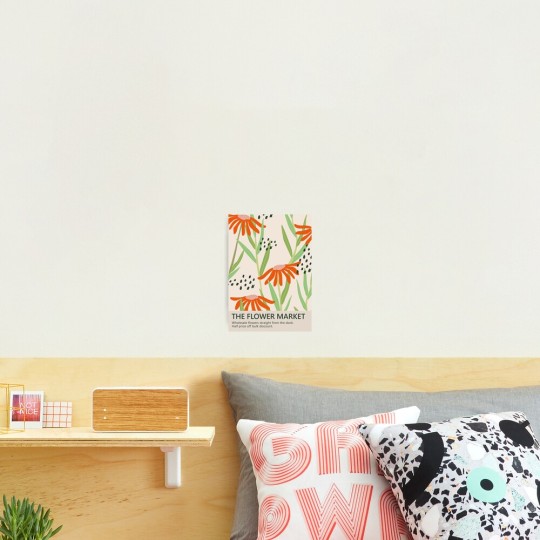
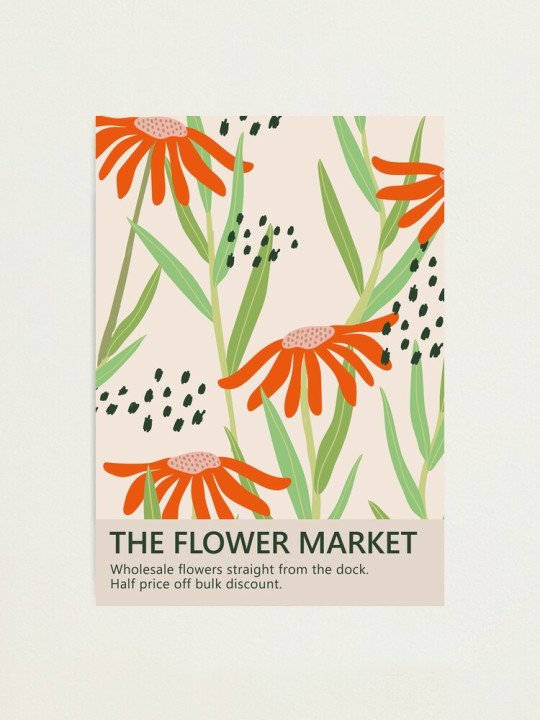


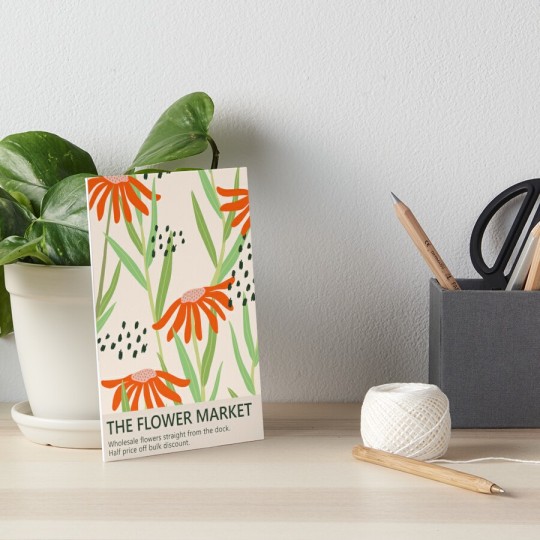
🌸 Introducing our Exquisite Canvas Print: Henri Matisse Inspired Flower Market! 🌸
Transform your space with a touch of artistic elegance! Our canvas print featuring a stunning floral design inspired by the legendary Henri Matisse is here to captivate your senses and elevate your home decor game.
🎨 Immerse yourself in Matisse's world: Known for his vibrant and expressive artistry, Matisse's love for nature shines through this mesmerizing floral design. Every brushstroke embodies his signature style, radiating joy and beauty.
🌺 Unleash the Power of Floral Serenity: The carefully crafted composition of vivid colors and organic shapes will infuse any room with an enchanting aura. Bring a breath of fresh air into your living room, bedroom, or office, and let the blossoming energy inspire you every day.
✨ Superior Quality, Lasting Impressions: Our canvas prints are meticulously crafted with top-notch materials and attention to detail. Experience the richness of colors, the depth of textures, and the impeccable clarity that will make this artwork the centerpiece of your space for years to come.
🎁 Perfect Gift for Art Enthusiasts: Looking for a unique and meaningful gift? Our Henri Matisse-inspired canvas print is sure to delight art lovers and anyone who appreciates the beauty of nature. Surprise your loved ones with a timeless piece that will make their hearts bloom!
🔥 Limited Time Offer: Don't miss out on the chance to own this exceptional canvas print. Visit HERE and order yours today! Be quick to secure yours as our limited stock won't last long.
📣 Share the Love: Help us spread the joy of Matisse's art by reblogging this post! Tag your friends who adore floral beauty and inspire them to bring a touch of Matisse into their lives.
💫 Art has the power to transform spaces and touch souls. Experience the magic of Henri Matisse's iconic flower design with our exclusive canvas print. Elevate your decor and let the radiance of nature bloom in your home. Order now! 💫
Buy Now "Henri Matisse Inspired Flower Market Floral Artistic Canvas Print"
#wall art#homedecor#decoration#homedecoration#canvas#henri matisse#design#art#poster#walldecor#MatisseArt#CanvasPrints#FloralDesign#ArtInspiration#HomeDecorIdeas#InteriorDesign#ArtisticExpression#MatisseInspired#ArtLovers#GiftIdeas#ArtisticGifts#FlowerArt#VibrantColors#MatisseInspiration#ArtisticHome#ArtCollectors#ArtEnthusiast#DecorInspo#MatisseFlowers#ModernArt
3 notes
·
View notes
Text
The poet Vincent Katz has a keen eye for the composition of a scene, and visual artists have influenced and sparked his poems. He first met the painter Paul Resika in Maine, one day in the mid-1970s, when he accompanied friends who visited Resika at the Skowhegan School of Painting and Sculpture. They looked at the canvases, introduced Vincent to Paul, and the two talked briefly about their mutual interest in poetry. “I told him I was reading Allen Ginsberg, Gary Snyder, and William Carlos Williams,” Vincent recalls. “He said he loved Shelley. In my memory, this instant connection lasted a mere five minutes.” Vincent admired Resika’s work as he got to know it after that day, “for its blending of abstract and representational elements, his often bright colors that seemed to evoke Baudelaire’s (and Matisse’s) luxe, calme, et volupté, and his seaside visions, which I learned derived from summers spent in North Truro, Massachusetts.” He continues, “As the decades went by, I always remembered our brief meeting in Skowhegan. It stuck with me as a kind of iconic affirmation of the importance of poetry (or the importance of anything, really) in the lives of two people, that they can share something.” Finally, in 2017, Vincent made an effort to meet Paul again, and began regularly visiting his studio in New York. The title poem of Katz’s Broadway for Paul was written after one such afternoon; the poems in its second section, including this one, take their titles from a series of gouaches Resika did in North Truro in the 1990s.
Encounter
for Oliver
Yesterday, as we walked from the town, And the light faded from the sky, I thought, How striking The dark shapes of buoys and barks In front of the still bay, and land opposite
And I thought, Poetry cannot suffice For this, only painting could evince This light, and evincing, might Reach an equivalent sense of calm Or overview, photography could not
Then my son said, Don’t under- Estimate the power of the word, And I thought, Perhaps? This morn, Again I see the sea, land opposite, Boats and air and clouds, and wonder

“Encounter” by Paul Resika, 1990 (gouache on paper, 7 x 10 1/4 )
. .
More on this book and author:
Learn more about Broadway for Paul by Vincent Katz and follow him @broadwayforpaul on Instagram.
Learn more about Paul Resika and view Resika’s “Sails” online at MoMA, “Still Boats and Moon” at the Whitney Museum of American Art, and a few of his other works online at the Smithsonian American Art Museum.
Visit our Tumblr to peruse poems, audio recordings, and broadsides in the Knopf poem-a-day series.
To share the poem-a-day experience with friends, pass along this link.
#KatzAudio#poetry#knopf#books#poem-a-day#knopf poetry#national poetry month#poetry month#knopfpoetry#poem#Broadway For Paul
4 notes
·
View notes
Text
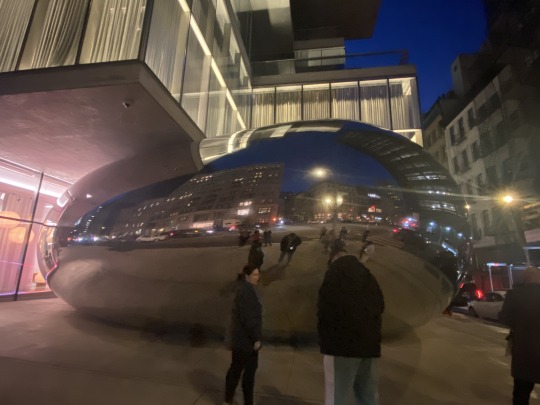
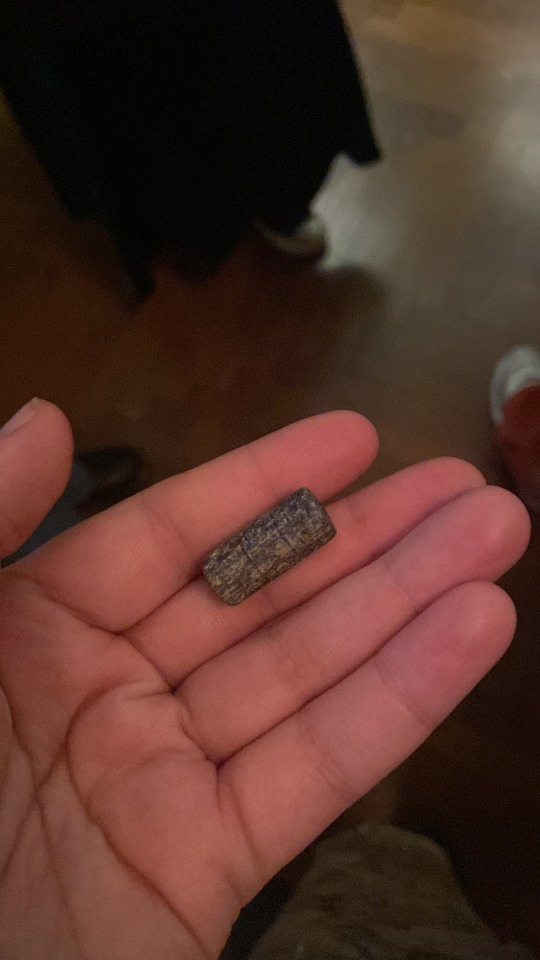
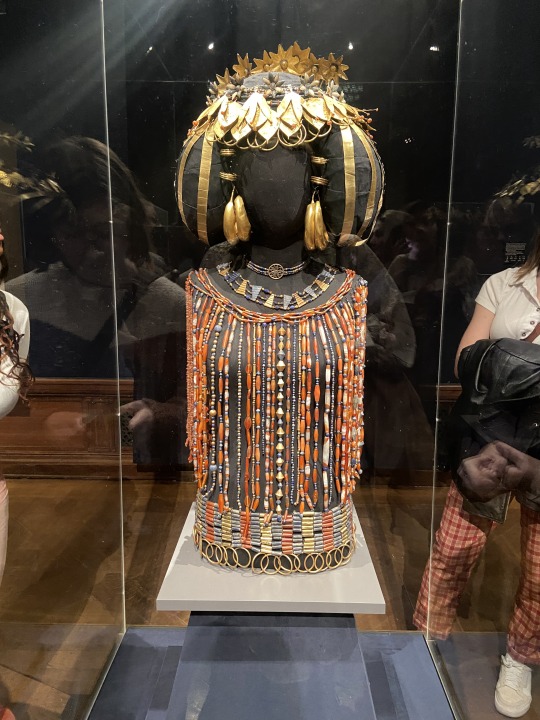

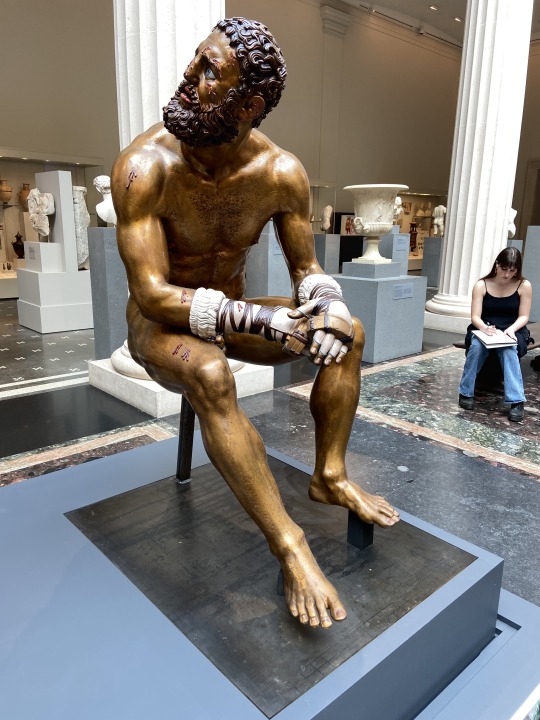

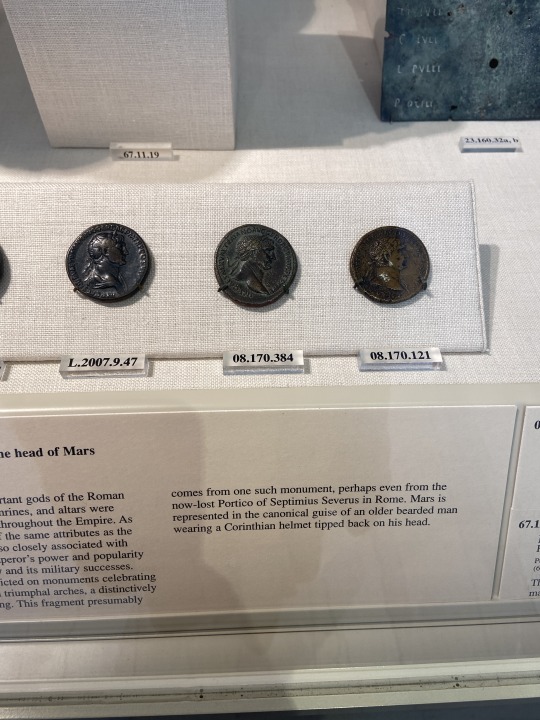
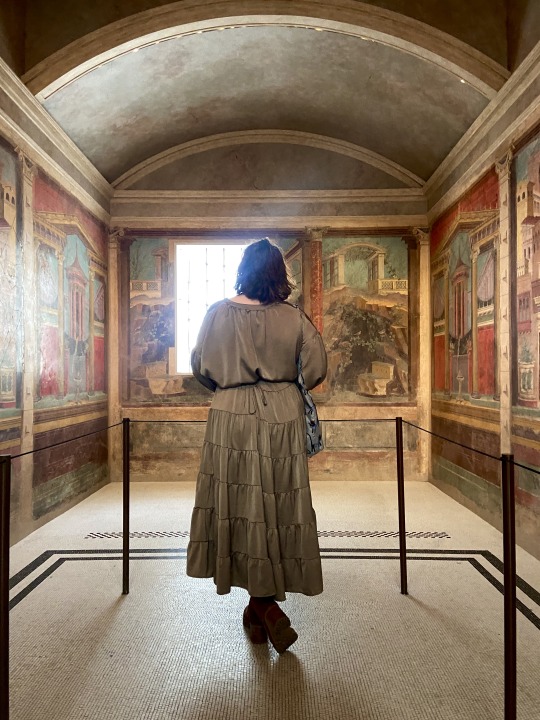
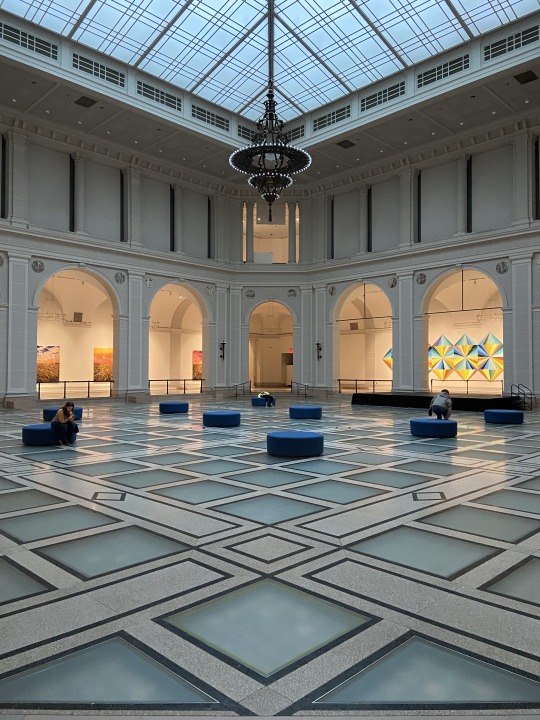

New York City: Feb. 14- Feb. 19
Friday, March 10, 2023
From February 14th-19th, I had the opportunity to go on a university class trip to New York City to meet with professionals in the Art History field and to explore the rich art scene of the city. This is the second trip of this sort that I have gone on with my school, but this trip was special because of the emphasis on meeting with art museum professionals- the field which I will be entering after graduation. During the week I was in the city, I visited the New York Public Library, the Morgan Library, MoMA, the MET, the Brooklyn Museum, and the Rubin Museum. We met with so many amazing professionals, including the chief curator of the Egyptian exhibit at the MET and one of the Egyptian artifact conservators who works at the MET as well.
On my first night in NYC, a couple of classmates and I explored the city in search of Anish Kapoor’s mini-bean under the jenga building. Visiting this newest iteration of Cloud Gate was a great way to start our art history trip- seeing this new piece of history that had recently been installed in the Big Apple. Visiting such an iconic piece of art, regardless of how one feels about Kapoor, was a grand way to kick off the trip!
On the 15th, after visiting some of the photo archives at the NYPL, our class attended a guided tour of the Morgan Library. We got to have such a surreal, humanizing, and unique experience during the tour when the docent pulled out a 5000 year old cylinder seal from ancient Mesopotamia and let us each hold it. My passion for art history was sparked when I first learned about ancient visual culture, so being able to hold this piece of history was a full-circle moment for me and my peers. It brought to life what we often can only view in photos or behind glass.
At the Morgan Library, we toured the exhibit “She Who Wrote: Enheduanna and Women of Mesopotamia, ca 3400-2000 BC.” It was all about the women of ancient Mesopotamia and how womanhood was understood during those times. We learned so many beautiful things about women deities who were bringers and takers of life, or wagers and enders of wars. A piece that really stood out to me was the costume for a Mesopotamian queen. The beading was gorgeous, featuring lapis lazuli- indicating the reliable trade the Mesopotamians would have had in what is considered modern-day Afghanistan. I noted that her headdress must have been an inspiration for Queen Amidala’s styling in the Star Wars franchise, calling back to the powerful women of our ancient civilizations.
After visiting the Morgan Library, we went to the MoMA. This being my second time at the museum in the last 10 months, I was comfortable visiting the pieces I missed the most- one of which being Matisse’s Dance. This painting always stuns me due to the grand scale of it and the use of vast fields of cool toned colors- green and blue.
On the 16th we spent the entire day at the MET. This was my second time at the MET as well, so I spent a majority of my time catching up where I left off last year- finally entering the wing of the Greek and Roman galleries where the cubiculi and mosaics are housed. The Chroma exhibit throughout the galleries was stunning to put it lightly! Classical sculpture is where my heart lies and finally I was seeing what the people I admire so much were seeing when these sculptures were at their prime. The Boxer sculpture has always been one of my favorites, so seeing it in such surreal detail was overwhelming and unforgettable. The Chroma exhibit had me imagining what my life would be like if I worked in the MET and got to study sculptures and look for remnants of pigment on them. It is groundbreaking research and I have such immense respect and appreciation for the brilliant art historians and scientists who are doing geeks like me this service.
Some things that were stunning and gripped me in tears for an hour were a mosaic of a woman in a wreath, coins depicting Trajan, and the vibrant cubiculi that I did not have a chance to visit last year. These are what it is all about for me. These are what my discipline mean to me! Seeing the mosaic mere inches from my face, as opposed to from around a roped-off corner as I did last year, allowed me to see all of the individual tesserae and imagine how it would have looked inside of a Roman villa. The coins with Trajan on them made me incredibly emotional, as I am somebody who studies Roman emperors. These were undeniable visual evidence that these subjects I devote so much of my studies to were real people! Real people who had real impacts on the world and who I only wish I could have met. The star of the show for me though were the cubiculi. I had been dying to finally enter one ever since I first studied Roman villas, particularly Pompeiian villas. As I stood inside of the cubiculum pictured, I took my time admiring all of the gorgeous frescoes. Frescoes I had only seen in textbooks and on powerpoint slides. There they were, right in front of my face. All the room needed was the proper furniture and I would have been exactly where my heart longs to be.
Lastly, on Friday the 17th, we visited the Brooklyn Museum as a class and later some of us visited the Rubin for a free guided experiential tour and DJ event. At the Brooklyn Museum, we got a tour from one of their museum educators of the Thiery Mugler exhibit. My goal is to be a museum educator, and to make museums enjoyable and understandable for every visitor. Our tour guide did exactly that for us. Part of our tour included ten minutes for us to go around the exhibit with provided paper and pencils, to draw any of the costumes we were drawn to and to think about the material or how the costume must have felt. She provided us with an activity that I definitely would have done if I were in the same position. That activity engaged our intrinsic motivation, allowing us to connect with a piece of our choosing, but it also encouraged us to think critically about the pieces in the exhibit. How would they have felt? Who would wear them? Why am I connecting to it? She showed me exactly how effective and necessary museum educators are in order to engage all visitors and to break down barriers of intimidation in museum spaces.
The Brooklyn Museum had a lounge area that I connected with during my individual expiration of the museum. Museum fatigue is real and can be a huge barrier to enjoyment for museum-goers. Not only was this room visually stunning, the ottomans were also art and welcomed visitors to be comfortable and relaxed. This is something that I am passionate about as I prepare for my future in museums. I know how important comfort is when people have so much going on in their days and lives. My respect for the Brooklyn Museum only went up that day, as I went down and laid on one of the ottomans.
At the end of the night, at the Rubin museum, I attended a guided tour of the galleries. The Rubin is a museum of Himalayan art and visual culture. The gallery is meant to be experienced rather than viewed. We explored our senses as we explored the galleries, we meditated, we transformed our energy into something beautiful. The whole design of the museum and tour were a unique take to museums and welcomed visitors into Himalayan Buddhist culture and practice. I think that this is a museum that everybody should visit if they have the opportunity to do so.
Overall, this trip did a lot to prepare and excite me mentally for my impending future. Soon I will be released into the world, no longer in school, no longer in a classroom. The professionals we met with during our trip provided a lot of insight into the many avenues and journeys one may endeavor to get to where they are going. My journey so far has had so many twists and turns, and it was comforting and affirming to hear their stories. I related to so many of them and I felt assured that at the end of the day, if I continue chasing my dream and my happiness, I will end up exactly where I belong. Being an art historian is so much more than being a student or being an academic. Art can be found anywhere: on the street, under buildings, in libraries, or in museums. Wherever there are people, there is art. Wherever there is art, there are art historians. Not everybody in the museum or art historical world comes from an art history background. The greatest thing I took away from this trip and the stories I heard at these various institutions is that achieving one's goals is all about accepting any and every opportunity for growth, as opposed to making some sort of five or ten-year plan and adhering strictly to it. I came out of the trip knowing that my path to being a museum educator is unclear but that I will get there as long as I continue chasing it.
#art history#museum#photography#mesopotamia#met#metropolitan museum of art#moma#modern art#new york city#nyc#university#student life#appalachian state university#class assignment#digital storytelling#museum education#dreams#goals#the future really isnt that scary#journal
5 notes
·
View notes
Text
Discover Unforgettable Experiences with Nice Holiday Packages

When it comes to planning a memorable getaway, Nice Holiday Packages offer an incredible opportunity to experience the stunning beauty of the French Riviera. Known for its dazzling Mediterranean coastlines, charming old town, and vibrant cultural scene, Nice captivates every visitor with its elegance and charm. With a wide range of Nice Holiday Tour Packages available, travelers can enjoy everything from beach relaxation to art explorations, all while soaking up the Mediterranean sun.
European Konnect makes it easy to explore the best of Nice by offering customized Nice Holiday Tourism Packages designed to suit every travel style and budget. Whether you're a solo traveler, honeymooner, or family vacationer, these packages are crafted to cover the most picturesque spots and offer seamless travel experiences. Imagine strolling along the iconic Promenade des Anglais, discovering the colorful markets in the Old Town, and enjoying breathtaking views from Castle Hill. With Nice Holiday Travel Packages, you can immerse yourself in the essence of Nice and experience both its natural beauty and rich cultural heritage.
For art enthusiasts, Nice is home to several impressive museums, including the Matisse Museum and the Museum of Modern and Contemporary Art. Each of these sites reveals different facets of Nice's artistic soul, allowing visitors to connect deeply with the city’s history and legacy. Nice Holiday Journey Packages offer guided tours to these cultural landmarks, where you can appreciate the work of artists who found inspiration in this picturesque locale.
Gastronomy is another highlight of any trip to Nice. The city’s culinary offerings range from seafood delicacies to Niçoise specialties like Socca and Salade Niçoise. Many Nice Holiday Packages include visits to local markets and food tours, allowing travelers to sample authentic dishes and learn about the local food culture. With a mix of fine dining options and quaint cafes, Nice is a paradise for food lovers eager to indulge in the flavors of the French Riviera.
Nature enthusiasts can also find plenty to enjoy in Nice. From exploring the coastal cliffs to hiking trails with panoramic views of the Mediterranean, Nice Holiday Tour Packages often include excursions to nearby natural reserves and scenic spots. This is a perfect way for adventure seekers to witness the breathtaking landscapes that make Nice one of the most visited cities in France.
European Konnect ensures that every travel package is filled with delightful experiences that cater to diverse interests. With our Nice Holiday Tourism Packages, you have the chance to explore Nice in depth, whether that means savoring wine at a local vineyard, wandering through historic landmarks, or simply lounging on sun-kissed beaches. Each package is thoughtfully curated to provide an immersive and hassle-free travel experience, making it easier for visitors to truly enjoy the beauty and ambiance of Nice. A journey to Nice is an invitation to unwind, explore, and fall in love with one of the most enchanting regions in Europe. With Nice Holiday Travel Packages designed to maximize comfort and adventure, your trip to Nice will be nothing short of unforgettable. Choose from our range of Nice Holiday Journey Packages today and prepare to create lifelong memories along the stunning French Riviera.
0 notes
Text
The Evolution of Patisserie: From Classic Desserts to Modern Innovations

Patisserie, the art of making delicate, exquisite desserts, has a rich and long-standing history dating to the past. It was first created in France in the past; it was reserved for the elite culinary establishments and their palates. Over time, the patisserie industry has changed and changed to meet the needs of various cultures, recipes, and styles, becoming more popular and loved all over the world. In the present, we're witnessing a thrilling combination of traditional techniques and contemporary, innovative innovations as pastry chefs explore different flavors, textures, and even presentations in a way that has never been seen before. This article focuses on the development of patisseries, from their roots in the past to the dazzling designs we find in contemporary bakeries. The article also touches on ways that aspiring bakers can acquire the knowledge and skills needed to excel in the ever-changing field of baking.
Origins of Patisserie: A French Legacy
The earliest traces of patisserie can be traced back to France, where the first pastry chefs developed desserts that were based on the most basic ingredients of high quality, like flour, butter, and sugar. Patisserie was originally designed to serve royalty and the wealthy and demanded the use of specialized skills. French standards for patisserie were established through the introduction of iconic desserts like eclair macarons and mille-feuilles, which are still loved to this day.
The Matisse of the seventeenth century grew more refined and sophisticated with the development of new techniques. Pastry chefs started to experiment with more intricate recipes, using cream fillings, layered cakes, and creative presentations. Chef," they also introduced the French phrase "patissier," which translates to "pastry chef," and was soon associated with creativity and culinary skill.
The Spread of Patisserie Across Borders
Europe, In the wake of the French culinary revolution at its peak, patisserie rapidly spread throughout Europe, and every country incorporated its unique local ingredients and recipes into the traditional French base. Chocolate For example, Italian chefs integrated their favorite mascarpone and ricotta cheeses, while Swiss pastry chefs incorporated chocolate, which is now an integral ingredient in numerous desserts.
The growth of patisserie has led to the creation of new types, like viennoiseries, that combine pastry with techniques used in breadmaking. These flaky, light treats like croissants, as well as Danish pastries, quickly became very popular as an addition to the menu of traditional sweets. They are now standard items in bakeries around the world.
As travel around the world increased in accessibility, so did the sharing of cooking techniques. Chefs with French training started opening patisseries in other parts of Europe, which allowed for more exploration of ingredients and tastes specific to various regions. The exchange between cultures significantly enhanced the pastry scene and led to a more varied selection of desserts.
The Birth of Modern Patisserie: A Fusion of Tradition and Innovation
The beginning of the 21st century was the start of a more innovative and diverse pastry. Due to the globalization process and the rising demand for culinary skills, pastry chefs across the globe challenged traditional boundaries, blending traditional methods with innovative, contemporary techniques.
The most significant innovation in modern pastry is the use of new flavorings and ingredients. These days, pastry chefs typically include exotic spices, like matcha from Japan, yuzu from Southeast Asia, and hibiscus from Africa, that introduce new distinctive flavors to classic recipes. This fusion of diverse ingredients has transformed patisserie into more than just an art form but also a thrilling place to express your creativity.
The presentation of patisserie has seen a significant change. Social media is now an increasingly popular site for food photography, and aesthetics are a major factor in the making of desserts. Modern desserts are usually attractive, well-designed, and often architecturally inspired. They are layered with edible decorations and striking colors, which make them as visually appealing as they are tasty. In addition, pastry chefs today employ techniques of molecular gastronomy, like gels, foams, and edible "smoke, to improve the experience of eating.
The Rise of Dietary-Specific Patisserie: Meeting Modern Needs
Due to the increasing prevalence of diet restrictions and food preferences, pastry has also adapted to accommodate the demands of a variety of diets. Gluten-free, dairy-free, vegan, and sugar-free sweets are available in abundance, which allows a larger public to indulge in these delicious desserts. Ingenuity: Making the delicate texture and flavor of traditional desserts that do not contain certain ingredients requires creativity, skill, and originality, which has prompted pastry chefs to explore alternatives such as coconut milk, almond flour, and sweeteners made from natural sources.
This move towards accommodating special dietary requirements has not just increased the number of customers who visit patisseries. Still, it has also provided further experimentation in the creation of desserts. Gluten: Making a mille-feuille without gluten, such as a gluten-free mille-feuille or an eclair that is vegan, requires chefs to modify the traditional methods and increase their knowledge of food.
Learning the Art of Modern Patisserie: Courses and Training
If you're interested in learning how to make Matisse, formal education is vital. pastryIn the present, pastry chefs can take advantage of specialized baking and pastry training courses that allow them to learn not only traditional techniques but also the latest innovations that make up the modern era of pastry.
Kolkata, In Kolkata, the growing demand for pastry chefs with experience is a factor in the development of courses that specialize in bakery and pastry arts. A bakery course in Kolkata will equip students with the hands-on experience and theoretical knowledge needed to succeed in the ever-changing art of pastry. The courses will cover fundamental techniques, from making classic French pastry to exploring contemporary, creative desserts. They also stress that presentation and ingredient choices are crucial, as are the creative processes that are crucial to the patisserie industry today.
The Future of Patisserie: Trends to Watch
The patisserie industry is evolving; it is gaining momentum with new trends that could define the future of patisserie. Sustainability has become a primary aspect of the culinary industry, and pastry is no exception. Pastry chefs are becoming more conscious of sourcing sustainable ingredients, cutting down on waste, and making "plant-based" desserts using natural organic and sustainable ingredients.
The application of technology is another way to transform the world of pastry. Digital tools, like 3D printing and custom-designed molds, enable pastry chefs to design intricate designs that are precise and consistent. Furthermore, chefs are working with AI to create recipes that are able to balance taste and texture in different ways, which adds an academic dimension to dessert creation.
In addition, the patisserie industry is becoming more interactive, including "deconstructed" desserts that allow customers to try different elements independently. This method not only improves the dining experience but also inspires creativity in presentation and the development of new tastes.
Embracing a Career in Patisserie
Patisserie, a blend of science and art, is still a favorite of both culinary lovers alike. If you are passionate about making desserts that go beyond the limits of flavor and presentation, an education in baking or the art of patisserie could be a great step towards it. The diploma bakery course in Kolkata offers a full-time education that blends the fundamentals of traditional patisserie and modern methods. Through hands-on experiences and professional guidance, students learn the necessary skills to bring their designs to life and also learn to adapt to the needs of the ever-changing and varied food and beverage industry.
As patisserie develops and evolves, its capacity to change and grow is one of the more fascinating and rewarding areas in food and beverage. If you're enjoying a classic dessert or marveling at an intricate layering of contemporary entremet, every dessert tells the story of innovation, tradition, and the unending desire for excellence.
0 notes
Text


His exhibition is a result of extensive research and vivid imagination, bringing to life the studios of iconic figures such as Pablo Picasso, Yayoi Kusama, Henri Matisse, Damien Hirst, Frida Kahlo, and many others.
1 note
·
View note
Link
Unleash your creative spirit with Matisse coloring pages. These sheets contain outlines of Matisse's most iconic works, offering both kids and adults a unique way to interact with art. Explore the abstract world of this French master as you fill in bold colors and immerse yourself in the artistry of coloring.PrintDownload
0 notes